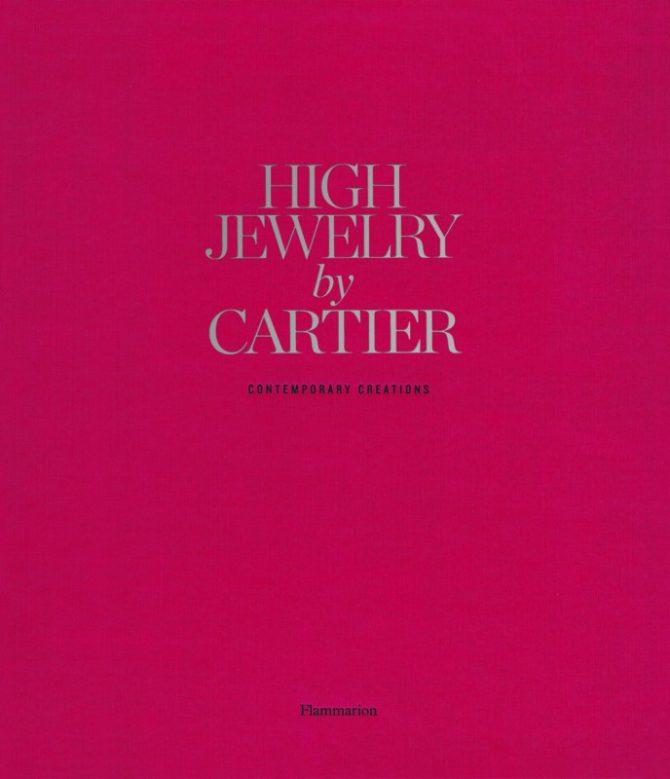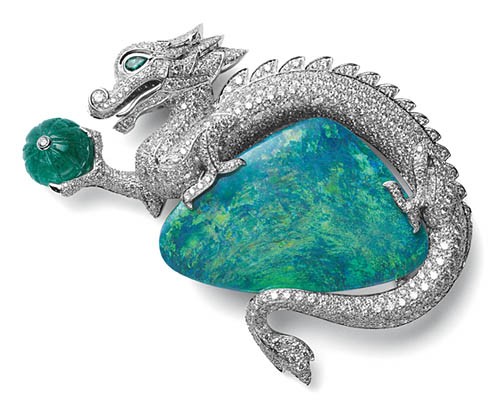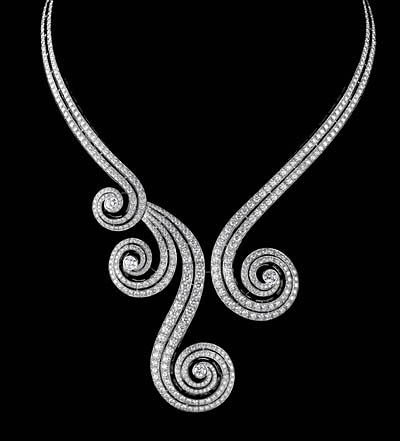High Jewelry by Cartier: Contemporary Creations

With its lustrous red satin cover, gleaming silver lettering and hefty size, High Jewelry by Cartier is a pleasure to handle even before you open it. Inside, it’s a visual feast, with more than 300 color images, many of them full-page, displaying every glittering detail of some of Cartier’s most gorgeous creations, along with design drawings, advertising posters and vintage photographs of the Cartier family and some of their most famous clients.
Subtitled “Contemporary Creations”, the book highlights the artistic threads and historic sources that have shaped the firm’s style over the decades: pure, clean lines and balanced colors as well as distinctive forms—panthers, dragons, orchids and other exotic flora—that characterize some of its most exuberant designs.

Platinum brooch with one opal, one ribbed emerald, brilliants, emerald eyes. Nils Hermann from High Jewelry by Cartier © Flammarion/Cartier, 2009
The text briefly recounts the history of the firm, which was founded in 1847, concentrating on the period starting in 1899 when it moved to 13 rue de la Paix. Still the location of the workshops and historic boutique, this is where the firm started designing its own jewelry rather than retailing the creations of other workshops. Shunning the then-fashionable Art Nouveau style for a more original interpretation of neoclassical designs, Cartier proved to be a pioneer by introducing platinum settings. More difficult to work with than gold or silver, requiring new tools and methods of casting, platinum was sturdy enough to allow for “tiny articulated settings that endowed jewelry with a natural drape”. The new designs had a light, supple look perfectly suited to natural forms like ferns and flowers.
Other themes emerged over time: Cartier’s designers were influenced by exotic lands and ancient civilizations—especially Russia, India and China—and fauna of all sorts, from snakes to peacocks. The famous panther was first introduced in a 1914 “panther skin” patterned watch and developed over time into a myriad of more or less naturalistic felines.

Necklace of white gold and brilliants. Nils Hermann from High Jewelry by Cartier © Flammarion/Cartier, 2009
While the text makes fascinating reading, the bulk of the book—and its glory—are the photographs. Shot against black or white backgrounds, the jewelry is often shown larger than life, with colors ablaze—the delicate hues of rose, yellow, blue and chocolate diamonds, the luster of multicolored pearls, the iridescent shimmer of smooth moonstones and opals. Every detail is lovingly captured, from the multicolored diamonds forming the spreading tail of a peacock to the onyx nose and emerald eyes of a panther whose body forms a ring and whose paws cuddle a cushion-cut sapphire.
Equally interesting are the stories behind the stones. Vintage shots show clients wearing some of the world’s most famous gemstones: Evalyn Walsh McLean wearing her 45-carat Hope Diamond; a 12-year-old Indian prince wearing the Star of the South, a 128-carat diamond reset by Cartier in 1928 for his maharajah father; Barbara Hutton in 1947, wearing a tiara studded with emeralds that once belonged to Russia’s Catherine the Great.
Design drawings show the artistic process behind the jewelry, and advertising photos—including a 1967 shot of star model Twiggy wearing a skinny sweater adorned by a bevy of butterfly brooches in diamonds, coral and onyx—show the evolution of the company’s style over time.
Jewelry, in French, is joaillerie—a word etymologically related to the word for joy. For anyone who takes pleasure in things of great beauty, High Jewelry by Cartier is a joy indeed.
High Jewelry by Cartier: Contemporary Creations, Flammarion, September 2010.
All photos from High Jewelry by Cartier: Contemporary Creations, Paris: Flammarion, 2009. © Flammarion S.A., Paris, 2009, © Cartier International, 2009.
Share to: Facebook Twitter LinkedIn Email
Leave a reply
Your email address will not be published. Required fields are marked *



